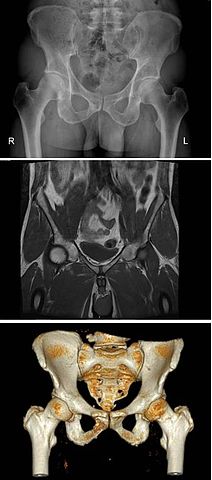Some Sitting Help
Stand up. Find your hip joints. Locate your “bikini” line, and find the place where, if you press into it, your pelvis will shoot back in space. That’s where your hip joint is. Note that this is just the frontal plane. Your hip joint is a 3D structure, and exists on the side and backplane of your pelvis also.
Place your thumbs in your hips joints and your hands around your leg bones, so that you can feel for the rotation of your thighs (femurs) as you flex and extend your pelvis. When you send your pelvis back in space, notice that your femurs internally rotate. You might be able to feel a slight widening in the sit bones. When you extend your hip joints, you will feel external rotation of the femurs, coupled with a narrowing of the sit bones.
You can also practice sitting in a chair. Explore a gentle motion of rocking forwards and backwards on your sit bones. Sense the widening of your sit bones as your rock forward, coupled with internal rotation of the femurs. Sense the narrowing of your sit bones as you rock backwards, coupled with external rotation of the thighs. Find a balance point with the pelvis slightly tilted forward (sit bones widening). This helps to establish the lumbar curve of your back and will make sitting upright feel much easier. The slight lumbar curve will also help to release the shoulders as the fascia of the back will tend to tug the shoulder blades down a bit.
How does this differ from how you ordinarily sit?
Most people have a hard time finding and moving from the hip joints. Do you bend your head forward or extend your chest instead of moving at the hip joint? To isolate the movement to your hip joints, it’s helpful to imagine a marble sliding down the chute of the spine. When it reaches the tailbone, that’s the moment to lean forward.
As a final note, this type of mechanical guidance does not sum up the Alexander technique, which I would frame as a holistic method for enhancing our conscious lived experience of being embodied. I offer this mechanical exploration, because so many of my students have discomfort sitting.
Knowing a little bit about the geometry of your bones can make a tiresome daily activity easier.











